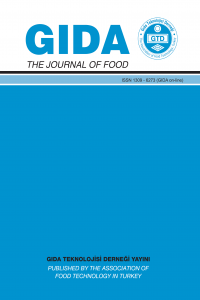TOTAL PHENOLIC, FLAVONOID, TANNIN CONTENTS AND ANTIOXIDANT PROPERTIES OF PLEUROTUS OSTREATUS AND PLEUROTUS CITRINOPILEATUS CULTIVATED ON VARIOUS SAWDUST
Abstract
In
this study, the possibility of using of chestnut (Castanea sativa) sawdust in Oyster mushroom (Pleurotus ostretatus and Pleurotus
citrinopileatus) cultivation was investigated. Additionally; Pleurotus ostreatus cultivation on the
substrates which was mixed of chestnut with black poplar (Populus nigra) and oriental spruce (Picea orientalis) was performed.
Bioactive properties of these mushroom and their growth mediums were also
examined. After a successful harvest, total phenolic, flavonoid, condensed tannin
contents and antioxidant properties of mushrooms’ methanolic extracts were
determined. Same analyses were also performed for mushrooms substrates. The
highest yield and biological efficiency was observed in P. ostreatus cultivated on 100% Castanea
sativa substrate. The highest total phenolic content (2.529±0.010 mg GAE/g)
was found in P. citrinopileatus cultivated
on C. sativa sawdust and its
substrate medium. Total flavonoid could not determine any mushroom. The highest
total condensed tannin (3.691±0.011 CE mg/g) content was observed in P. ostreatus cultivated on C. sativa sawdust and its substrate
medium; the highest ferric reducing antioxidant power (11.761±0.020 μmol FeSO4.7H2O/g)
was seen in P. ostreatus mushroom
cultivated on 50% P. orientalis + 50%
C. sativa and 100% C. sativa substrate medium. The highest
free radical scavenging activity of DPPH was in P. citrinopileatus and 100% C.
sativa sawdust and 100% C. sativa
substrate medium.
References
- Bhatti M, Jiskani M, Wagan K, Pathan M, Magsi M. 2007. Growth, development and yield of oyster mushroom, Pleurotus ostreatus(Jacq. Ex. Fr.) Kummer as affected by different spawn rates. Pak J Bot, 39, 2685-2692.
- Yalinkilic M, Altun L, Baysal E, Demirci Z. 1994. Development of mushroom cultivation techniques in Eastern Black Sea Region of Turkey. Project of The Scientific and Technical Research Council of Turkey (TUBITAK), No. TOAG, 985:377.
- Garcha H, Dhanda S, Khanna P. 1984. Evaluation of various organic residues for the cultivation of Pleurotus (Dhingri) species. Mush Newslett Trop, 5, 13-16.
- Gregori A, Švagelj M, Pohleven J. 2007. Cultivation techniques and medicinal properties of Pleurotusspp. Food TechnolBiotechnol, 45, 238–249.
- Das N, Mukherjee M. 2007. Cultivation of Pleurotus ostreatus on weed plants Bioresource Technol, 98, 2723-2726.
- Zadrazil F. 1978. Cultivation of Pleurotus. In: The Biology and Cultivation of Edible Mushrooms, Academic Press, New York, pp. 521-557.
- Khanna P, Garcha H. 1984. Pleurotus mushroom-A source of food protein. Mushroom News Lett Tropics, 4, 9-14.
- Upadhyay RC, Singh M. 2011. Production of edible mushrooms. In: Industrial Applications. Springer, pp. 79-97.
- Turkoglu A, Duru ME, Mercan N, Kivrak I, Gezer K. 2007. Antioxidant and antimicrobial activities of Laetiporus sulphureus (Bull.) Murrill. Food Chem, 101, 267-273.
- Attarat J, Phermthai T. 2014. Bioactive compounds in three edible Lentinus mushrooms. Walailak J SciTechnol, 12, 491-504.
ÇEŞİTLİ TALAŞLARDA ÜRETİLEN PLEUROTUS OSTREATUS VE PLEUROTUS CITRINOPILEATUS MANTARLARININ TOPLAM FENOLİK, FLAVONOİD VE TANEN İÇERİKLERİ VE ANTİOKSİDAN ÖZELLİKLERİ
Abstract
Bu çalışmada Pleurotus ostreatus ve Pleurotus citrinopileatus’un (İstiridye
mantarı/kayın mantarı) kestane (Castane asativa)
odunu talaşındaki üretim olanakları üzerinde durulmuştur. Ayrıca; Kestane
talaşının; karakavak (Populus nigra)
ve doğu ladini (Picea orientalis)
talaşları ile karıştırıldığı ortamlarda Pleurotus
ostreatus üretimi denenmiştir. Üretimlerin ardından elde edilen mantarların
ve yetişme ortamlarının biyoaktif özellikleri araştırılmıştır. Başarılı bir
hasat periyodundan sonra mantarların metanolik eksraktları üzerinden toplam
fenolik, flavonoid ve kondanse tanen içerikleri ve antioksidan özellikleri
belirlenmiştir. Aynı deneyler mantar subsratları için de tekrar edilmiştir. En
yüksek verim ve biyolojik etkinlik değeri %100 Castanea sativa ortamında gelişen P. ostreatus mantarında gözlenmiştir. En yüksek fenolik içerik (2.529±0.010 mg
GAE/g) C. sativa talaşında üretilen P. citrinopileatus mantarında ve kendi
yetişme ortamında bulunmuştur. Hiç bir mantarda flavonoid içeriği tespit
edilememiştir. En yüksek kondanse tanen içeriği (3.691±0.011 CE mg/g) %100 C. sativa talaşında üretilen P.
ostreatus’da ve kendi yetişme substratında; en yüksek demir indirgeyici
antioksidan aktivite (11.761±0.020 μmol FeSO4.7H2O/g) %50
P. orientalis + %50 C. sativa karışımında üretilen P. ostreatus’ta ve %100 C. sativa besin ortamında gözlenmiştir. En yüksek DPPH radikali
temizleme aktivitesi %100 C. sativa ortamında üretilen P.
citrinopileatus mantarında ve %100
C. sativa besin ortamlarında
görülmüştür.
References
- Bhatti M, Jiskani M, Wagan K, Pathan M, Magsi M. 2007. Growth, development and yield of oyster mushroom, Pleurotus ostreatus(Jacq. Ex. Fr.) Kummer as affected by different spawn rates. Pak J Bot, 39, 2685-2692.
- Yalinkilic M, Altun L, Baysal E, Demirci Z. 1994. Development of mushroom cultivation techniques in Eastern Black Sea Region of Turkey. Project of The Scientific and Technical Research Council of Turkey (TUBITAK), No. TOAG, 985:377.
- Garcha H, Dhanda S, Khanna P. 1984. Evaluation of various organic residues for the cultivation of Pleurotus (Dhingri) species. Mush Newslett Trop, 5, 13-16.
- Gregori A, Švagelj M, Pohleven J. 2007. Cultivation techniques and medicinal properties of Pleurotusspp. Food TechnolBiotechnol, 45, 238–249.
- Das N, Mukherjee M. 2007. Cultivation of Pleurotus ostreatus on weed plants Bioresource Technol, 98, 2723-2726.
- Zadrazil F. 1978. Cultivation of Pleurotus. In: The Biology and Cultivation of Edible Mushrooms, Academic Press, New York, pp. 521-557.
- Khanna P, Garcha H. 1984. Pleurotus mushroom-A source of food protein. Mushroom News Lett Tropics, 4, 9-14.
- Upadhyay RC, Singh M. 2011. Production of edible mushrooms. In: Industrial Applications. Springer, pp. 79-97.
- Turkoglu A, Duru ME, Mercan N, Kivrak I, Gezer K. 2007. Antioxidant and antimicrobial activities of Laetiporus sulphureus (Bull.) Murrill. Food Chem, 101, 267-273.
- Attarat J, Phermthai T. 2014. Bioactive compounds in three edible Lentinus mushrooms. Walailak J SciTechnol, 12, 491-504.
Details
| Primary Language | English |
|---|---|
| Journal Section | Articles |
| Authors | |
| Publication Date | May 4, 2017 |
| Published in Issue | Year 2017 Volume: 42 Issue: 3 |

